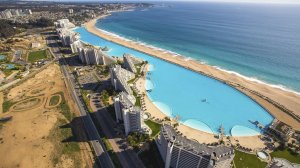Technique developed to produce and maintain attractive ‘lagoons’ at low costs


CLEAR WATERS Crystal Lagoons use closed circuits and sensors to maintain low levels of water consumption
A method to construct and maintain artificial lagoons is being opened to the South African market after proving successful abroad, according to multinational artificial lagoon company Crystal Lagoons.
According to the company, its engineering technology makes it possible to bring waterfronts to inland areas, contributing to urban development on the continent, opening up previously unfeasible areas to development and increasing sales prices and sales velocity.
Crystal Lagoons states that, owing to South Africa having, on average, more than 250 days of sunshine a year, its artificial lagoons are ideal for outdoor recreation purposes. However, South Africa’s “sprawling and fast-growing urban centres, especially those inland, provide little by way of water amenities close to where people live, work or play”.
Crystal Lagoons can use any type of water – fresh, salt or brackish – to provide a sustainable solution for the efficient use of water resources. The lagoons are ideal for a wide range of recreational activities, including swimming, kayaking, paddle boarding and sailing, all within a safe environment, providing value to real estate projects and people who want to live at the water’s edge.
Patented in 160 countries, Crystal Lagoons’ technology was first conceived when scientist and entrepreneur Fernando Fischmann dreamed of creating a large, crystal-clear lagoon to provide swimming and watersports facilities to visitors to the San Alfonso del Mar real estate project, in Chile. He aimed to develop a technology that would be able to maintain a large body of water efficiently.
Conventional swimming pool technology requires maintaining high and permanent levels of residual chlorine, or other disinfectants in the water, to provide permanent disinfection to the pool and avoid contamination of the water by external agents, such as bathers. Crystal Lagoons’ solution is to apply small quantities of disinfection pulses of oxidants/microbiocides within the lagoon, which are applied according to specific algorithms, and in specific patterns. The result is that the amount of additives consumed is up to 100 times less than used for swimming pools. A typical lagoon has about 400 sensors/injectors for such purposes.
The company’s crystalline lagoons can benefit a development . . . opening up previously unfeasible locations to development, according to Crystal Lagoons regional director: Africa Alastair Sinclair. “Crystal Lagoons has disrupted the real estate market in every country it has entered by challenging the real estate paradigm of ‘location, location, location’.”
“Crystal Lagoons’ technology is environment friendly, as it involves very low water consumption because the lagoons work on closed circuits, using up to 30 times less water than a golf course and just half of the water required by a park of the same size,” he says.
Sinclair adds that Crystal Lagoons offers a significant benefit to a country like South Africa, where both water and energy are scarce resources. “It creates opportunities for the large tracts of undeveloped inland areas, as well as the possibility of converting less accessible parts of our vast coastline into safe recreational areas for families to enjoy,” he notes.
Crystal Lagoons boasts a portfolio of 300 projects in different stages of development in over 60 countries. The 12.5 ha lagoon at the Citystars Sharm El Sheikh tourist development, in Egypt, beat the company’s previous Guinness world record-breaking project – the iconic 8 ha San Alfonso del Mar lagoon – in Algarrobo, Chile.
Meanwhile, Crystal Lagoons is currently transforming the world-famous Las Vegas strip into a beach-front. The development is expected to add an exciting new dimension to an already vibrant tourist destination, whose location in the Mojave Desert previously made a watersports venue on such a large scale unimaginable.
“There is a lot of interest from local developers who are looking for an amenity to set themselves apart, especially in residential developments with no access to water for leisure activities,” concludes Sinclair.
Article Enquiry
Email Article
Save Article
Feedback
To advertise email advertising@creamermedia.co.za or click here
Comments
Press Office
Announcements
What's On
Subscribe to improve your user experience...
Option 1 (equivalent of R125 a month):
Receive a weekly copy of Creamer Media's Engineering News & Mining Weekly magazine
(print copy for those in South Africa and e-magazine for those outside of South Africa)
Receive daily email newsletters
Access to full search results
Access archive of magazine back copies
Access to Projects in Progress
Access to ONE Research Report of your choice in PDF format
Option 2 (equivalent of R375 a month):
All benefits from Option 1
PLUS
Access to Creamer Media's Research Channel Africa for ALL Research Reports, in PDF format, on various industrial and mining sectors
including Electricity; Water; Energy Transition; Hydrogen; Roads, Rail and Ports; Coal; Gold; Platinum; Battery Metals; etc.
Already a subscriber?
Forgotten your password?
Receive weekly copy of Creamer Media's Engineering News & Mining Weekly magazine (print copy for those in South Africa and e-magazine for those outside of South Africa)
➕
Recieve daily email newsletters
➕
Access to full search results
➕
Access archive of magazine back copies
➕
Access to Projects in Progress
➕
Access to ONE Research Report of your choice in PDF format
RESEARCH CHANNEL AFRICA
R4500 (equivalent of R375 a month)
SUBSCRIBEAll benefits from Option 1
➕
Access to Creamer Media's Research Channel Africa for ALL Research Reports on various industrial and mining sectors, in PDF format, including on:
Electricity
➕
Water
➕
Energy Transition
➕
Hydrogen
➕
Roads, Rail and Ports
➕
Coal
➕
Gold
➕
Platinum
➕
Battery Metals
➕
etc.
Receive all benefits from Option 1 or Option 2 delivered to numerous people at your company
➕
Multiple User names and Passwords for simultaneous log-ins
➕
Intranet integration access to all in your organisation















